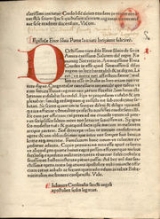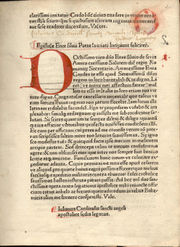
Johannes Mentelin
Encyclopedia

Sélestat
Sélestat is a commune in the Bas-Rhin department in Alsace in north-eastern France.In 2006, Sélestat had a total population of 19,459. The Communauté de communes de Sélestat et environs had a total population of 35,397.-Geography:...
; died December 12, 1478 in Strasbourg
Strasbourg
Strasbourg is the capital and principal city of the Alsace region in eastern France and is the official seat of the European Parliament. Located close to the border with Germany, it is the capital of the Bas-Rhin département. The city and the region of Alsace are historically German-speaking,...
) was a pioneering German
Germany
Germany , officially the Federal Republic of Germany , is a federal parliamentary republic in Europe. The country consists of 16 states while the capital and largest city is Berlin. Germany covers an area of 357,021 km2 and has a largely temperate seasonal climate...
book printer
Printer (publisher)
In publishing, printers are both companies providing printing services and individuals who directly operate printing presses. With the invention of the moveable type printing press by Johannes Gutenberg around 1450, printing—and printers—proliferated throughout Europe.Today, printers are found...
and bookseller of the incunabulum
Incunabulum
Incunable, or sometimes incunabulum is a book, pamphlet, or broadside, that was printed — not handwritten — before the year 1501 in Europe...
time. In 1466, he published the first printed Bible
Bible
The Bible refers to any one of the collections of the primary religious texts of Judaism and Christianity. There is no common version of the Bible, as the individual books , their contents and their order vary among denominations...
in the German language
German language
German is a West Germanic language, related to and classified alongside English and Dutch. With an estimated 90 – 98 million native speakers, German is one of the world's major languages and is the most widely-spoken first language in the European Union....
, the Mentelin Bible.
Life
In 1447, Johannes Mentelin gained the rights of a Strasbourg citizen. He was first a "Goldschreiber" (calligrapher and book scribe) by profession and worked in addition as an episcopal notaryScrivener
A scrivener was traditionally a person who could read and write. This usually indicated secretarial and administrative duties such as dictation and keeping business, judicial, and history records for kings, nobles, temples, and cities...
. Exactly when and where he learned the technique of book printing is not known. Since at the end of the 1450s, when Mentelin founded his Strasbourg printery, there was still no other place where printing was done besides Mainz
Mainz
Mainz under the Holy Roman Empire, and previously was a Roman fort city which commanded the west bank of the Rhine and formed part of the northernmost frontier of the Roman Empire...
, it is likely that he either got his knowledge directly there or through a middleman. Such a go-between might have been Heinrich Eggestein
Heinrich Eggestein
Heinrich Eggestein is considered, along with Johannes Mentelin, to be the earliest book printer in Strasbourg and therefore one of the earliest anywhere in Europe outside Mainz.- Life :Before he came to Strasbourg in the beginning of the 1440s, Heinrich Eggestein had already...
. It is suspected that he had been introduced to the trade of book printing during his stay in Mainz from Johannes Gutenberg. He did not set up his own Offizin (an old German term for a book printery) until the middle of the 1460s. Due to a lack of sources, the final clarification of this question must unfortunately remain unanswered for now. From the available data, it can however be concluded that Johannes Mentelin was the first book printer active in Strasbourg (and thus one of the first anywhere in Europe), even before Heinrich Eggestein.
The first printing which carries Mentelin's name is Augustine
Augustine of Hippo
Augustine of Hippo , also known as Augustine, St. Augustine, St. Austin, St. Augoustinos, Blessed Augustine, or St. Augustine the Blessed, was Bishop of Hippo Regius . He was a Latin-speaking philosopher and theologian who lived in the Roman Africa Province...
's Tractatus de arte praedicandi from the year 1465. However, it is assumed that Johannes Mentelin had already begun to print significantly earlier, probably even already in 1458. His oldest known printed work is a Latin
Latin
Latin is an Italic language originally spoken in Latium and Ancient Rome. It, along with most European languages, is a descendant of the ancient Proto-Indo-European language. Although it is considered a dead language, a number of scholars and members of the Christian clergy speak it fluently, and...
Bible printed with 49 lines per page ("B49"), whose first volume is dated 1460. As Johannes Gutenberg's Bible was printed with 42 lines per page, Mentelin's had fewer pages and proved handier.
Johannes Mentelin quickly achieved business success, which made him a prosperous man. In 1466, he was even awarded a coat of arms
Coat of arms
A coat of arms is a unique heraldic design on a shield or escutcheon or on a surcoat or tabard used to cover and protect armour and to identify the wearer. Thus the term is often stated as "coat-armour", because it was anciently displayed on the front of a coat of cloth...
by Emperor Frederick III
Frederick III, Holy Roman Emperor
Frederick the Peaceful KG was Duke of Austria as Frederick V from 1424, the successor of Albert II as German King as Frederick IV from 1440, and Holy Roman Emperor as Frederick III from 1452...
. After about 20 years as a book printer, Mentelin died on December 12, 1478 in Strasbourg. He was buried in the cemetery of the (no longer existing) St.-Michael's-Chapel. His grave was later removed and is now inside Strasbourg Cathedral
Strasbourg Cathedral
Strasbourg Cathedral or the Cathedral of Our Lady of Strasbourg is a Roman Catholic cathedral in Strasbourg, France. Although considerable parts of it are still in Romanesque architecture, it is widely consideredSusan Bernstein: , The Johns Hopkins University Press to be among the finest...
. His two daughters married the book printers, Martin Schott and Adolf Rusch
Adolf Rusch
Adolf Rusch von Ingweiler was a notable German printer and publisher. He was the first printer north of the Alps to print in Antiqua.- Life and work :...
. The latter, also called the printer with the bizarre R, took over the Offizin.
Work
About 40 printed works are ascribed to Johannes Mentelin's Strasbourg Offizin. His printing and publishing list contained predominantly theologicalTheology
Theology is the systematic and rational study of religion and its influences and of the nature of religious truths, or the learned profession acquired by completing specialized training in religious studies, usually at a university or school of divinity or seminary.-Definition:Augustine of Hippo...
and philosophical
Philosophy
Philosophy is the study of general and fundamental problems, such as those connected with existence, knowledge, values, reason, mind, and language. Philosophy is distinguished from other ways of addressing such problems by its critical, generally systematic approach and its reliance on rational...
works in Latin, whose purity of text was taken care of by scholarly proofreaders. Among others, works of Augustine, Thomas Aquinas
Thomas Aquinas
Thomas Aquinas, O.P. , also Thomas of Aquin or Aquino, was an Italian Dominican priest of the Catholic Church, and an immensely influential philosopher and theologian in the tradition of scholasticism, known as Doctor Angelicus, Doctor Communis, or Doctor Universalis...
, Aristotle
Aristotle
Aristotle was a Greek philosopher and polymath, a student of Plato and teacher of Alexander the Great. His writings cover many subjects, including physics, metaphysics, poetry, theater, music, logic, rhetoric, linguistics, politics, government, ethics, biology, and zoology...
, John Chrysostom
John Chrysostom
John Chrysostom , Archbishop of Constantinople, was an important Early Church Father. He is known for his eloquence in preaching and public speaking, his denunciation of abuse of authority by both ecclesiastical and political leaders, the Divine Liturgy of St. John Chrysostom, and his ascetic...
, Isidore of Seville
Isidore of Seville
Saint Isidore of Seville served as Archbishop of Seville for more than three decades and is considered, as the historian Montalembert put it in an oft-quoted phrase, "le dernier savant du monde ancien"...
and Albertus Magnus
Albertus Magnus
Albertus Magnus, O.P. , also known as Albert the Great and Albert of Cologne, is a Catholic saint. He was a German Dominican friar and a bishop, who achieved fame for his comprehensive knowledge of and advocacy for the peaceful coexistence of science and religion. Those such as James A. Weisheipl...
were issued. However, classical texts of antiquity
Classical antiquity
Classical antiquity is a broad term for a long period of cultural history centered on the Mediterranean Sea, comprising the interlocking civilizations of ancient Greece and ancient Rome, collectively known as the Greco-Roman world...
(such as Virgil
Virgil
Publius Vergilius Maro, usually called Virgil or Vergil in English , was an ancient Roman poet of the Augustan period. He is known for three major works of Latin literature, the Eclogues , the Georgics, and the epic Aeneid...
's Opera and the Comoediae of Terence
Terence
Publius Terentius Afer , better known in English as Terence, was a playwright of the Roman Republic, of North African descent. His comedies were performed for the first time around 170–160 BC. Terentius Lucanus, a Roman senator, brought Terence to Rome as a slave, educated him and later on,...
) were also published. As the only German book printer, Mentelin printed Medieval court literature, such as Wolfram von Eschenbach
Wolfram von Eschenbach
Wolfram von Eschenbach was a German knight and poet, regarded as one of the greatest epic poets of his time. As a Minnesinger, he also wrote lyric poetry.-Life:...
's Parzival and the Jüngerer Titurel of Albrecht von Scharfenberg.
However, his first printing of a Bible in vernacular
Vernacular
A vernacular is the native language or native dialect of a specific population, as opposed to a language of wider communication that is not native to the population, such as a national language or lingua franca.- Etymology :The term is not a recent one...
language stands out, the so-called Mentelin Bible, one of the first printed books in the German language. The Mentelin Bible was reprinted in the southern German region a further thirteen times by various printers up until the Luther Bible
Luther Bible
The Luther Bible is a German Bible translation by Martin Luther, first printed with both testaments in 1534. This translation became a force in shaping the Modern High German language. The project absorbed Luther's later years. The new translation was very widely disseminated thanks to the printing...
.
Literature
In German- Geldner, F.: Die deutschen Inkunabeldrucker. Ein Handbuch der deutschen Buchdrucker des XV. Jahrhunderts nach Druckorten. Teil 1. Das deutsche Sprachgebiet. Hiersemann, Stuttgart 1968. ISBN 3-7772-6825-9
- H. Harthausen: Johannes Mentelin. In: Lexikon des gesamten Buchwesens (LGB). Publ. by Severin Corsten. 2nd new, completely revised and expanded edition. Vol. V. Hiersemann, Stuttgart 1989. p. 145. ISBN 3-7772-9904-9
- Karl Schorbach: Der Straßburger Frühdrucker Johann Mentelin (1458-1478): Studien zu seinem Leben und Werke. Mainz, 1932.
- E. Voulliéme: Die deutschen Drucker des fünfzehnten Jahrhunderts. 2nd edition. Verlag der Reichdruckerei, Berlin 1922.
External links
- Johannes Mentelin in the Humanist Library of SélestatHumanist Library of SélestatThe Humanist Library in Sélestat is one of the most important cultural treasures of Alsace, France. According to a traditional saying, Alsace has three great treasures: Strasbourg Cathedral, the Isenheim Altarpiece in Colmar and the Humanist Library in Sélestat....
- Johannes Mentelin In Allgemeine Deutsche Biographie (ADB). Vol. 21, p. 370. In German
- Mentelin in the Catholic Encyclopedia
- Inkunabelkatalog Deutscher Bibliotheken (Incunabulum Catalog of German Libraries, INKA): List of the printed works of Mentelin accessible. In German

